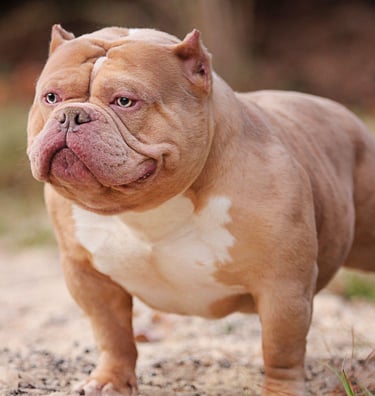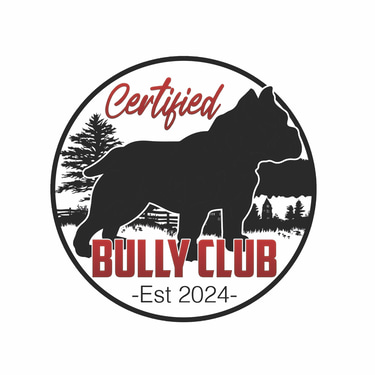Breed Standards
Review the standards for each breed to make sure your dog meets the requirements which are evaluated at shows by our judges.
American Bully
GENERAL APPEARANCE:
The American Bully ought to convey a sense of significant strength relative to its size. It is a sturdy, medium to large-sized dog with a muscular physique and a blocky head. The American Bully should display a strong bone structure with a hefty build and appearance. This breed is a companion animal that demonstrates confidence, enthusiasm for life, and a strong desire to engage and bond with its family, making the American Bully an ideal pet for families.
HEAD:
• The American Bully is characterized by its heavy, large, and broad head, which showcases the breed's traits.
• Its head is medium in length, deep, and wide, featuring a well-defined skull with noticeable cheek muscles and a distinct, deep stop.
• Ears are positioned high and can either be left natural or cropped.
• All eye colors are permitted, with the exception of albinism (which appears pinkish to red), resulting in disqualification. Blue eyes and lack of pigmentation around the eyes are seen as undesirable.
• Eye shape should range from oval to almond, positioned low in the skull and set widely apart. Round eyes are not desirable, and bulging or protruding eyes are considered faults.
• The visibility of the haw should be kept to a minimum.
Faults: Excessively visible haw. Eyes not matching in color. Bulging or protruding eyes. Disqualifying Faults: Albinism in eyes.
• The muzzle should be short to medium in length and broad in width, being shorter than the skull's length. The distance from the tip of the nose to the stop should be about one-third the distance from the tip of the nose to the occiput; however, it shouldn't be so short that it compromises normal breathing. The muzzle should have a blocky or slightly squared appearance and drop away sharply below the eyes. The top line of the muzzle should be straight, and the nose must not appear pointed or turned up in profile.
• The jaws should be well-defined.
• The under jaw should be horizontal and aligned with the muzzle, never rising upward.
• Lips should be semi-closed and even, with minimal looseness acceptable but not preferred.
Faults: Muzzle excessively long or snipey; muzzle so short that it disrupts normal breathing; insufficient pronounced cheek and deep stop; weak under jaw; under jaw tilting upward; nose turning up or being pushed back; excessive flews.
• The upper teeth should tightly meet the lower teeth outside, exhibiting a scissor bite.
Faults: Level bite, overshot bite, undershot bite, and wry bite. Serious Faults: Severely overshot or undershot bites measuring 1/4 inch (0.6 cm) or more.
• The nose should be large with wide-open nostrils. All colors and pigments are acceptable except for albinism (which is light pink).
NECK:
Robust and strong, with a slight arch, tapering from the shoulders to the rear of the skull. Should be compact to medium in size with little to no excess skin.
Defects: Neck that is too slender or weak; neck that is either too short or too lengthy.
BODY:
• A heavily muscled, massive, and compact medium-length body that conveys a strong sense of power for its size, showcasing the characteristics typical of the American Bully breed.
• The ribs are well-rounded, resulting in a barrel-shaped chest with closely grouped ribs; the rib cage should reach the elbow or slightly lower.
• The forelegs are positioned fairly wide apart to allow for proper chest development.
• The chest should be broad, deep, and well-filled, but not so exaggerated that it hinders normal movement.
FOREQUARTERS:
• The shoulders should be muscular with broad blades positioned widely apart and sloping back well. The length of the upper arm should be roughly equal to that of the shoulder blade, forming an angle of about 35 to 45 degrees at the joint.
• The forelegs must be straight, strong, and robust, with large or round bone structure; the pasterns should be short, straight, and nearly vertical. The feet should point straight ahead.
• The measurement from the withers to the elbow should match the distance from the elbows to the ground. While dogs that have a slightly shorter distance from the elbows to the ground are permissible, they are not preferred.
Faults: Upright shoulders; a steep and forward-angled scapula (shoulder blade). An upper arm that is too short. Feet that are either turned in or out; bowing of the front legs; down at the pasterns; splayed or flat feet; or excessively long toes.
HINDQUARTERS:
• Well-developed muscles with hocks that are let down, standing straight without turning in or out.
• The balance of muscular development, angulation, and width of the hindquarters should match that of the forequarters.
• When seen from the back, the legs should be straight and parallel.
• The croup should have a slight downward slope.
Faults: Hocks turning in or out; cow hocks; sickle hocks; narrow hindquarters; straight or excessively angulated stifle joints; bowed legs.
COAT AND SKIN:
• The coat is short, shiny, firm, and feels smooth when touched.
• The fur should not exceed ½ inch (1.27 cm) in length.
Faults: A coat that is curly or wavy.
Serious Faults: An overly long coat.
COLOR OF COAT:
• Any colors and patterns are allowed, including the Merle/blotched pattern as per competition rules.
SIZE:
• Dogs must be healthy and should not become overweight to the point of obesity.
• Weight - There is no specific weight requirement for the breed.
• Height and weight should be in proportion to the body structure.
• Height - Refer to Variety Amendments for details.
• All varieties should display “Bully” characteristics and breed type traits as outlined in the American Bully Standard, which are essential components of breed type for the American Bully breed.
GAIT:
• The American Bully exhibits a proud and confident demeanor, while being highly aware and alert to its environment.
• The dog's movement should be effortless and strong. The action must be free, unrestrained, vigorous, and driven powerfully from the rear. The front reach should be moderate and harmonized with the rear.
• The legs should not turn inward or outward, nor should they cross or interfere with one another.
• Each leg should move on the same plane, maintaining minimal convergence with the leg on the same side.
• The backline should stay level, with only slight flexing.
Faults: Rolling; pacing; sidewinding; hackney action; paddling or pounding. Not moving on the same plane; legs overreaching; legs crossing over in front or behind; rear legs moving too closely or touching.
TEMPERAMENT:
Despite the American Bully's intimidating and powerful look, its temperament is gentle. They are excellent with children and show remarkable friendliness towards strangers, other dogs, and various animals. Any signs of human or dog aggression, extreme shyness, or vicious behavior are highly atypical for the American Bully and are seen as undesirable traits.
FAULTS:
Faults to be penalized but not disqualifications for showing are:
• Both eyes not matched in color
• Overly visible haw
• Bulging or protruding eyes
• Muzzle too long or snipey
• Lack of pronounced/deep stop
• Weak underjaw
• Underjaw turning up
• Albinism nose (light pink)
• Nose turning up or pushed back
• Tail too long or too short (approx. 1 inch (2.5 cm) from point of hock)
• Curled tail (gay tail)
• Level or flush bite
• Overshot or Undershot bite
• Wry or cross bite
• Neck too thin or weak
• Neck too short or too long
• Upright shoulders; steep and forward scapula (shoulder blade)
• Upper arm too short
• Severe turned fronts (in or out)
• Bowed front legs
• Down at the pasterns (weak pasterns)
• Splayed or flat feet
• Long toes
• Hocks turning in or out; cow hocked
• Curly or wavy coat
• Movement: Rolling, pacing, sidewinding, hackney action, and paddling or pounding
• Not moving on the same plane – legs over reaching, crossing over in front or rear, or rear legs moving too close or touching
SERIOUS FAULTS:
Faults to be heavily penalized but not disqualifications for showing are:
• Severely overshot or undershot (1/4 inch (0.6cm)or more)
• Kinked tail
• Twisted tail
• Knotted tail
• Fused tail
• Overly Short tail
• Long coat
DISQUALIFICATIONS:
• Displaying or possessing aggressive behavior towards humans
• Pink or Albino eyes
• Merle pattern/Blotched per competition
• Unilateral or bilateral cryptorchidism (missing one or both testicles)
• Unilateral or bilateral deafness (deafness in one or both ears)
• Screwed tail
• Bobbed tail
• Docked tail
THE AMERICAN BULLY IS BROKEN UP INTO 5 DIFFERENT CLASSES (STANDARD, POCKET, CLASSIC, XL, AND MICRO), EACH CLASS HAS DIFFERENT HEIGHT REQUIREMENTS BUT MUST FOLLOW THE SAME BREED STANDARD!
HEIGHT REQUIREMENTS ARE LISTED BELOW FOR EACH CLASS:
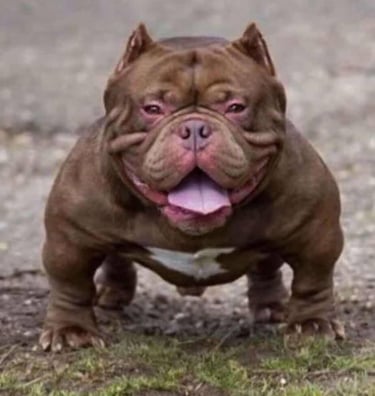

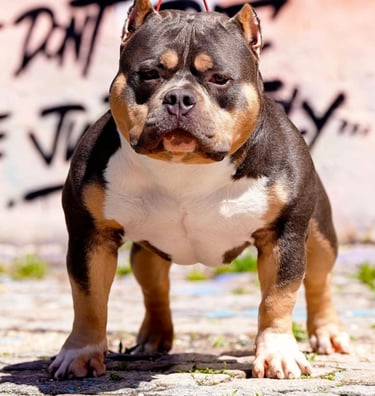

STANDARD BULLY- Males 17 inches – 20 inches (43 cm – 51 cm) at the withers. Females 16 inches – 19 inches (40 cm – 48 cm) at the withers. Important to note that the Standard American Bully dogs are not to be penalized for exhibiting heavily muscled, massive, bulky body type.
POCKET BULLY- Pocket Bully's is determined by its adult height. Males under 17 inches (43 cm) and no less than 14 inches (36 cm) at the withers. Females under 16 inches (40cm) and no less than 13 inches (33 cm) at the withers.
CLASSIC BULLY- Males 17 inches – 20 inches (43 cm – 51 cm) at the withers. Females 16 inches – 19 inches (40 cm – 48 cm) at the withers.
It’s important to recognize that the Classic Bully is defined by its physique and build. This includes dogs of both sexes that possess lighter body structures and reduced overall mass, while still showcasing “bully” characteristics.
Examples of Bully Characteristics – Broad/heavy heads; short/square muzzles; thicker bones, muscles, and a compact physique.
The Classic Bully variation is an American Bully dog with lighter body structures (less dense bone) and lower overall mass (reduced substance) compared to the Standard American Bully. Other than this distinction, the Classic Bully variety adheres to the same standards as the Standard American Bully.
XL BULLY- a XL Bully is determined by its adult height. Males over 20 inches (51 cm) – 23 inches (57 cm) at the withers. Females over 19 inches (48 cm) – 22 inches (54 cm) at the withers.
It’s important to highlight that the XL Bully breed is merely a taller version of the Standard American Bully. XL Bully dogs possess the same structure, body shape, and breed characteristics as the Standard American Bully, and they are anticipated to have a heavily muscled, substantial, and robust physique.
MICRO BULLY- The micro American bully starts at 13in and under for both males and females. They should have the same features as an standard American Bully just on a smaller frame
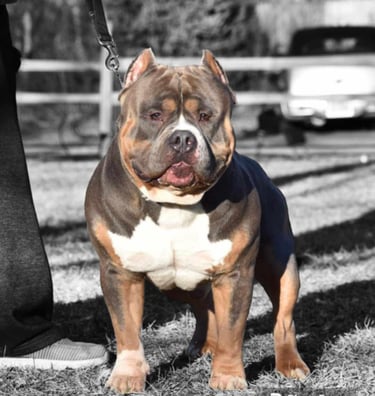

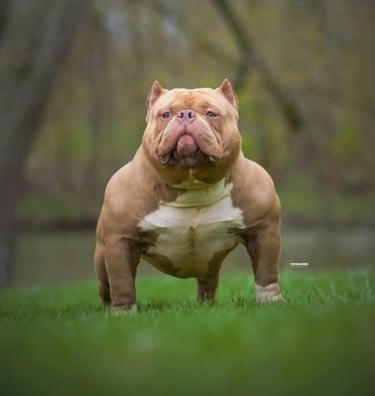

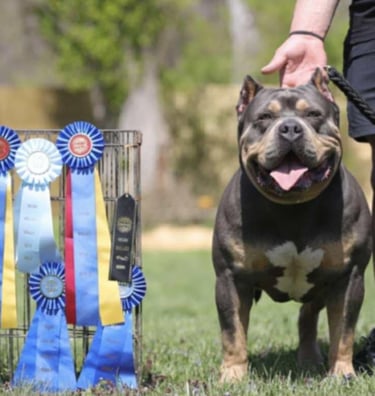

Shorty Bull
GENERAL IMPRESSION:
Shorty Bulls, commonly known as, are stocky and muscular bulldogs that are small in size. They possess athletic abilities and remarkable agility. Shorty Bulls® have a strong eagerness to please, are very intelligent, and have friendly dispositions. They make excellent family pets and are quite tolerant of children and other animals. These dogs are bred to be well-rounded companions for families. Shorties have a joyful outlook on life and are quite entertaining. They can easily adjust to various living situations, whether it be in an apartment or on a farm. Their grooming needs are minimal. Shorty Bulls should never show extreme shyness or aggression.
HEIGHT:
The popularity of Shorty Bulls has risen in recent years. Their charming appearance, compact size, and friendly nature make them a wonderful pet for anyone in search of a companion. Unlike their larger relatives, Shorty Bulls are easier to care for and have lower food and exercise requirements. One reason for their growing popularity is that they are excellent indoor pets. Their small stature makes them perfect for apartments, as they do not need vast spaces to be comfortable. Moreover, Shorty Bulls require minimal grooming as they do not shed excessively, making them ideal for those with allergies or for owners who prefer not to spend a lot of time on grooming. 15 inches and under (over 15 inches results in disqualification)
WEIGHT:
40 lbs. Dogs can weigh over 40 lbs, but it should be proportionate to their height. Obesity is considered a fault.
HEAD:
A round head with typical bulldog characteristics is preferred. The eyes should be set apart and should not protrude. The nose should have a slight upward tilt and can be either black or liver-colored. Dudley noses are regarded as a cosmetic fault.
BITE:
All dogs must have an undershot bite, though it should not protrude.
EYES:
Eyes can come in any color, although brown is preferred. They should be oval-shaped and should not protrude from the skull.
EARS:
Ears should be cropped close to the head. In countries where cropping is prohibited, dogs can show with natural ears that can either be dropped or rose-shaped and symmetrical. Prick ears are disqualified from the show ring.
BODY:
The body should be short between the withers and tail. The chest should be wide for the height and have a depth that reaches the elbow. A compact appearance is desirable; the width of the front and hindquarters should be proportional, avoiding a narrow rear. The chest may be broader than the rear, but narrow hindquarters are considered a fault.
SHOULDERS AND RUMP:
The shoulders and rump should be well-rounded and muscular, contributing to an overall impression of strength. A slight rise over the loins is acceptable but should not be excessive.
LEGS:
Legs should have substantial bone structure and be proportionate to the body. Legs that are too long in relation to the body or have fine bones are serious faults. Cow hocks and pigeon toes are also faults.
FEET:
Feet should be tight with straight pasterns being ideal. Splayed feet and weak pasterns are faults.
TAIL:
The tail must be short, either docked or screw-tailed. Long tails are not allowed in the show ring.
COLOR:
All coat colors are permissible except for black and tan, and merle.
TEMPERAMENT:
Dogs should be good-natured and even-tempered. Extreme shyness or excessive aggression is considered a fault.
FAULTS:
Obesity
Dudley Noses
Narrow hindquarters
Cow hocks
Pigeon toes
Splayed feet
Weak pasterns
Extreme shyness
Undue Aggression
DISQUALIFICATIONS:
Height over 15"
Pricked ears
Long Tails
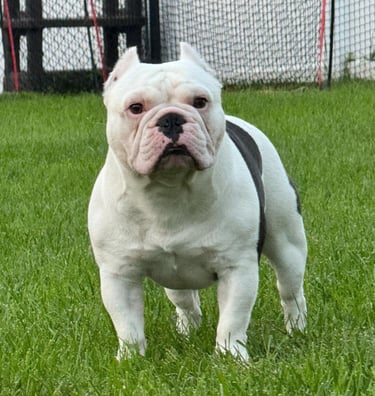

Olde English Bulldog
GENERAL APPEARANCE:
The ideal Olde English Bulldogge is a loyal, courageous dog of medium size with a large powerful head and stout muscular body. Olde English Bulldogges are athletic and most importantly of very good health, males are free breeders and females are free whelpers. The Olde English Bulldogge is devoid of all breathing issues and is capable of enjoying outdoor activity without concern except in extreme heat, temperament is very stable and trustworthy making them a loyal companion, capable protector and the ultimate family member. Olde English Bulldogges thrive on pleasing their owners and are very trainable. The typical lifespan of an Olde English Bulldogge is between 10 and 14 years.
SIZE, PROPORTION, SYMMETRY:
Height : Males – 18 to 20 inches at the shoulder. Females – 17 to 19 inches at the shoulder.
WEIGHT:
Between 50 to 70 pounds for females and 65 to 85 pounds for males. Although height and weight above the standard is to be discouraged, there is no penalty as long as the dog is well proportioned, otherwise correct and balanced.
HEAD:
Large and high, moderately sunken between the eyes (medial furrow). The circumference of the head should be equal to or greater than the dog’s height at the shoulder. A narrow head or one that appears too small for the body is a fault.
EARS:
Rose ears set well on the sides of the head are preferred. Dropped ears are acceptable as long they are small, not “hound like”. Full pricked ears that stand up on top of the head should be considered a serious fault.
MUZZLE:
Broad, deep and short with moderate wrinkling. The bite is undershot with the bottom jaw turning up noticeably. Lower canines should not protrude. Muzzle too long (more than 3 inches), scissor bite or even bite are disqualifying faults. Muzzle should be no shorter than 1 ½”. Wry jaw is a disqualifying fault.
EYES:
Wide apart and of moderate size. Any color is acceptable. However, odd eyes (one dark, one blue or light) should be considered non preferred. Misshapen or bugged eyes are a serious fault. Lacking pigment around the eyes is undesirable. Crossed eyes or non-symmetrically shaped eyes are a disqualifying fault.
NOSE:
Broad with open nostrils (nares) with no sign of air restriction. The nose should not be pushed up between the eyes. From the stop to the end of the nose must be at least one and one half inches. The nose should be a solid color. Lacking pigment is a serious fault. A nose lacking all pigment is a disqualifying fault.
NECK, BODY:
Short to medium in length and very muscular flowing into the shoulders and should not be set on the dog so it appears to stop at the shoulders.
CHEST:
Ribs should be well sprung (rounded) and the chest wide and deep. Depth of chest should be at least to the elbows. A hollow or narrow chest (slab sided) should be considered a serious fault.
BACK:
Males should appear square and balanced. Females should appear similar with consideration given for body length. Short with a very slight rise from the shoulders to a slight drop in the croup is preferred. A level back is acceptable as long as the tail does not come straight off the top of the back.
TAIL:
A pump handle tail that naturally reaches the hock is preferred, screwed short or a docked tails are acceptable. The pump handle tail should be carried low and not over the back of the dog.
FOREQUARTERS, HINDQUARTERS, FEET:
Forelegs should be straight and wide apart, neither bowing out nor turning in. There should be significant bone substance. Elbows should be relatively close to the body. Lacking bone and substance is very undesirable. Elbows that are loose or “fiddle fronts” are a disqualifying fault. “East / West” forelegs are a serious fault. Rear legs should exhibit significant bend of stifle so to allow for good movement. They should be well muscled. Straight or “posty” rear legs are a serious fault. Cow hocks are a disqualifying fault. Feet should be Round, tight both front and rear, and the pasterns should be strong. Weak pasterns and/or splayed feet are disqualifying faults.
COAT AND SKIN:
The coat is short. A wavy coat or a long coat is a disqualifying fault; there should not be any signs of feathering on the legs, ears or neck area. OEBs with any sign of long or wavy coats are NOT to be registered.
COLOR OF COAT:
Any color is acceptable with no preference of one over another.
GAIT:
Dogs should have a balanced gait that drives off the rear and is complimented by reach allowing the dog to cover ground with a sense of power. Dogs should single track. Pacing or crabbing is a serious fault.
TEMPERAMENT:
Disposition should be outgoing and happy. While a watchful nature may be expected at home, human aggression without provocation is a disqualifying fault.
DISQUALIFICATIONS:
Human aggression without provocation.
Weak pasterns and/or splayed feet.
Cow hocks.
A nose lacking all pigment.
Crossed eyes or non-symmetrically shaped eyes.
Muzzle should be no shorter than 1 ½”.
Wry jaw.
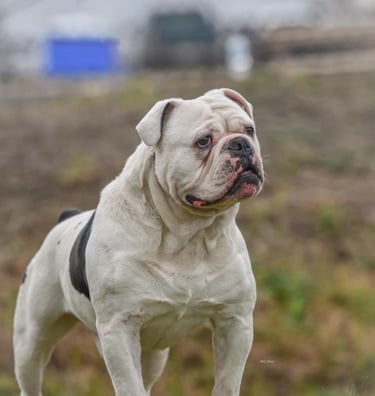

French Bulldog
GENERAL APPEARANCE:
The French Bulldog has the appearance of an active, intelligent, muscular dog of heavy bone, smooth coat, compactly built, and of medium or small structure. Expression alert, curious, and interested.
SIZE, PROPORTION, SYMMETRY:
The weight should not surpass 30 pounds. Proportion–The distance from the withers to the ground should be in harmony with the distance from the withers to the start of the tail, ensuring that the animal looks compact, well-balanced, and proportionate. Substance–The animal should have a muscular build and robust bone structure. All aspects should be evenly distributed and relate well to one another; no feature should be overly prominent or lacking in quality, causing the animal to seem poorly proportioned.
HEAD:
The head is large and square-shaped. The eyes can be any color, are spaced widely apart, positioned low in the skull, as far from the ears as possible, round in shape, moderately sized, and neither deeply set nor protruding. No haw or white of the eye should be visible when looking straight ahead. Ears are referred to as bat ears, broad at the base, elongated, with a rounded tip, set high on the head but not too closely together, and held upright with the openings facing forward. The ear leather should be fine and soft. Any ears that are not bat ears disqualify the breed. The top of the skull is flat between the ears; the forehead, however, is slightly rounded rather than flat. The muzzle is broad, deep, and well positioned, with well-defined cheek muscles. The stop is clearly defined, creating a hollow groove between the eyes, with prominent wrinkles that form a soft fold over the very short nose; the nostrils are broad, with a clear line separating them. The nose can be any color. The flews are thick and broad, hanging over the lower jaw at the sides, meeting the underlip at the front and covering the teeth, which are not visible when the mouth is closed. The underjaw is deep, square, broad, overshot, and well turned up.
NECK, TOPLINE, BODY:
The neck is robust and elegantly arched, featuring loose skin around the throat. The back has a slight roach in its shape with a gentle decline just behind the shoulders; it is strong and compact, broad at the shoulders and tapering toward the loins. The body is short and well-rounded. The chest is wide, deep, and voluminous; well-ribbed with a belly that is tucked up. The tail can be either straight or screwed (but never curly), short in length.
FOREQUARTERS:
Forelegs are short, stout, straight, muscular and set wide apart. Dewclaws may be removed. Feet are moderate in size, compact and firmly set. Toes compact, well split up, with high knuckles and short stubby nails.
HINDQUARTERS:
Hind legs are strong and muscular, longer than the forelegs, so as to elevate the loins above the shoulders. Hocks well let down. Feet are moderate in size, compact and firmly set. Toes compact, well split up, with high knuckles and short stubby nails; hind feet slightly longer than forefeet.
COAT AND SKIN:
The coat is somewhat fine, shiny, short, and sleek. The skin is soft and loose, particularly around the head and shoulders, creating wrinkles.
COLOR OF COAT:
All colors acceptable. All nose colors acceptable.
GAIT:
Proper gait involves double tracking with extension and propulsion; the movement is unrestricted, liberating, and energetic.
TEMPERAMENT:
Polite, flexible, and easygoing companions with a loving personality and a calm temperament; typically lively, vigilant, and fun-loving, yet not excessively rowdy.
DISQUALIFICATIONS:
Bat ears.
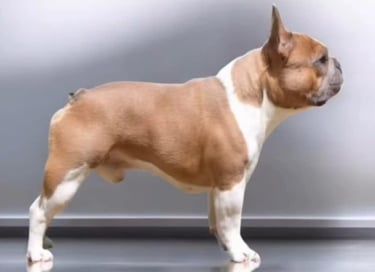

Exotic Bully
GENERAL APPEARANCE:
The Exotic Bully is an offshoot of the American Bully, characterized by its more pronounced and exaggerated physical traits compared to the American Bully. Since this class is still in its early stages, the existing standards will be revised to better serve the breed and its breeders. The Exotic Bully's general appearance makes it easily distinguishable from other Bully breeds due to its highly exaggerated features.
HEAD:
The head of the Exotic Bully boasts a distinct and strong physical presence. It is of medium size when compared to the Extreme Exotic and Miniature Exotics.
JAW:
The jaw is well-defined and sculpted, complementing the overall head structure.
MUZZLE:
The length and shape of the muzzle correspond to the dog’s overall head size but should not be mistaken for that of the standard American Bully. The muzzle's length must not surpass ¼ of the dog's total head length (muzzle-occiput). The junction where the muzzle meets the stop should not exceed a certain angle, creating a near-vertical appearance from the side. The transition between the top skull and stop must be an abrupt drop, lacking any tapering or fading into the muzzle.
EARS:
Both cropped and natural ears are acceptable, though cropped is preferred.
FAULTS:
An elongated or snipey muzzle and a weak jaw that detracts from the overall muscular look of the dog are considered faults.
TEETH:
The bite should be a scissor bite, without being over or undershot. As the breed continues to develop, a maximum allowed length of ½ inch will be revised to a shorter standard once the breed's consistency is deemed suitable. (Dogs with underbites should not have teeth visible when the mouth is closed.)
NECK:
The neck of the Exotic Bully should be robust and arched, with a clear point of connection where the crest and withers converge.
BODY:
The body should be muscular and distinctly separate from that of the American Bully, with a compact and bulky overall appearance. Movement must be smooth and effortless in its natural stance or gait.
FOREQUARTERS:
The forequarters should be strong and muscular with broad shoulders. Given that the Exotic naturally carries more mass, the feet should remain straight. While feet that are turned in or out are permissible, breeding towards this trait is not advised. Bowed fronts are allowed but are neither desired nor recommended.
HINDQUARTERS:
The hindquarters should be strong and muscular, with slight turns accepted due to the breed's mass and developmental phase. Overall size should be in harmony with the forequarters and the dog's total length. Moderate angulation is preferred, though faults and disqualifications in the show ring will depend on the judge's assessment.
BACK:
The back should be short and must not extend beyond the dog's overall height from the ground to the withers.
TAIL:
The tail should be positioned low on the buttocks and of medium length, aligning with the hock. Other tail types, such as kinked, corkscrew, or short tails, are not recommended despite being accepted.
COAT:
The coat should be short in length, presenting a fine and smooth look, while the skin should be moderately loose, with acceptable wrinkles attributable to its exaggerated characteristics.
SIZE:
The general guideline for the dog's overall size is height-length squared.
Example: If the height of the dog from ground to withers is 16 inches then the length of the dogs back from withers to croup should not exceed that length. The bully breed is a compact yet functional companion. Overall height should be from 13-18 inches from ground to withers. All parts of the Exotic Bully should complement the other and be in proportion to the complete frame.
TEMPERAMENT:
The Exotic classes are companions and love nothing more than to please owners and people in general. Human and dog aggression are serious faults and disqualifications when showing and are encouraged to not breed towards.
